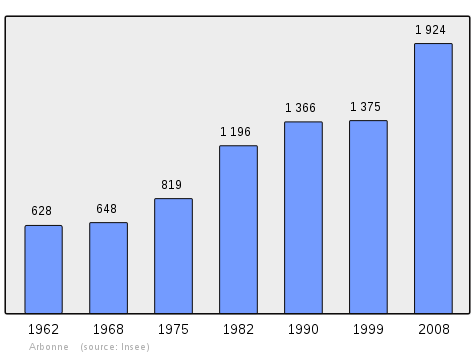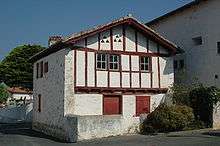Arbonne
Arbonne (Basque: Arbona) is a commune in the Pyrénées-Atlantiques department in the Nouvelle-Aquitaine region of southwestern France.
Arbonne Arbona | |
|---|---|
The Town Hall | |
.svg.png) Coat of arms | |
Location of Arbonne 
| |
 Arbonne  Arbonne | |
| Coordinates: 43°25′58″N 1°33′00″W | |
| Country | France |
| Region | Nouvelle-Aquitaine |
| Department | Pyrénées-Atlantiques |
| Arrondissement | Bayonne |
| Canton | Ustaritz-Vallées de Nive et Nivelle |
| Intercommunality | CA Pays Basque |
| Government | |
| • Mayor (2008–2020) | Marie-Josèphe Mialocq |
| Area 1 | 10.59 km2 (4.09 sq mi) |
| Population (2017-01-01)[1] | 2,223 |
| • Density | 210/km2 (540/sq mi) |
| Time zone | UTC+01:00 (CET) |
| • Summer (DST) | UTC+02:00 (CEST) |
| INSEE/Postal code | 64035 /64210 |
| Elevation | 5–94 m (16–308 ft) (avg. 21 m or 69 ft) |
| 1 French Land Register data, which excludes lakes, ponds, glaciers > 1 km2 (0.386 sq mi or 247 acres) and river estuaries. | |
Geography
Arbonne is located some 6 km south of Biarritz and 3 km east of Bidart. It is part of the Urban area of Bayonne and is located in the former province of Labourd. Access to the commune is by road D255 from Biarritz in the north passing through the village and continuing south to Saint-Pée-sur-Nivelle. The D655 branches off the D255 in the south of the commune and goes to Ahetze. The A63 autoroute passes through the northern tip of the commune but has no access from the commune. In the south of the commune is the hamlet of Le Hameau d'Arbonne. The rest of the commune is mainly farmland with patches of forest especially in the north.
Located in the drainage basin of the Adour, the commune is traversed by the Uhabia, a small coastal river that flows into the ocean at Bidart, and its tributaries: the Zirikolatzeko erreka and the Ruisseau d'Argelos.
The Ruisseau de Pemartin also flows through the commune and there is an extensive network of streams throughout the commune.[4]
Places and Hamlets[5]
- Aguerrea
- Alhorga[6]
- Allexarrea
- Arditegia
- Arretxea
- Berrueta
- Cassoua
- Diharzenea
- Etchardia
- Guichenea
- Gure Egoitza
- le Hameau d'Arbonne
- Harriague[6]
- Hegoasea
- Katalienea
- Kuttuenea
- Larreburua
- Magnienea
- Menta[6]
- Mestelan Beherea[6]
- Mestelania
- Moleresia
- Mundustenea
- Pemartikoborda
- Pemartin[6]
- Perukain[6]
- La Place[6]
- le Pouy[6]
- Saskoenea
- Tribulenea
- Xantxienea
- Xokobia
- Ziburria
- Ziburriako Errota
Toponymy
The commune name in Basque is Arbona.[7]
Brigitte Jobbé-Duval[3] indicated that 'Arbona meant "place of tree stumps".
The following table details the origins of the commune name and other names in the commune.
| Name | Spelling | Date | Source | Page | Origin | Description |
|---|---|---|---|---|---|---|
| Arbonne | Narbona | 1186 | Raymond | Bayonne | Village | |
| Narbone | 1349 | Orpustan | ||||
| Alhorgako Erreka | L'Alhorga | 1863 | Raymond | A tributary of the Uhabia flowing from Saint-Pée-sur-Nivelle and Ahetze | ||
| Berrueta | Berhouetta | 1863 | Raymond | Farm | ||
| Harriague | Harriague | 1863 | Raymond | Hamlet | ||
| Hurmalague | Hurmalague | 1863 | Raymond | Hamlet | ||
| Menta | Menta | 1198 | Raymond | Bayonne | Hamlet | |
| Mente | 1523 | Raymond | Chapter | |||
| Mestelan Beherea | Mestelan | 1760 | Raymond | Collations | Farm (a prebend of this name was present in the Arbonne church) | |
| Mesthelan | 1863 | Raymond | ||||
| Pemartin | Pémartin | 1863 | Raymond | Farm | ||
| Perukain | Perucam | 13th century | Raymond | Bayonne | Hamlet | |
| Pérucain | 1863 | Raymond | ||||
| La Place | La Place | 1863 | Raymond | Hamlet | ||
| Le Pouy | la chapelle de Pouy près Bayonne | 1751 | Raymond | Intendance | Farm | |
| Pouy | 1863 | Raymond |
Sources:
- Raymond: Topographic Dictionary of the Department of Basses-Pyrenees, 1863, on the page numbers indicated in the table. (in French)[6]
Origins:
History
The oldest lord of Arbonne whose names are known are from the Sault family, Viscounts of Labourd. At the end of the 14th century the lordship was owned by the Saint-Julien family (originally from Lower Navarre) and then in 1408 to the Amezqueta family.[12]
The Act of 4 March 1790,[13] which determined the new administrative landscape of France by creating departments and districts, created the Department of Basses-Pyrénées to bring together Béarn, the Gascon lands in Bayonne and Bidache, and three French Basque provinces. For these three provinces three districts were created: Mauléon, Saint-Palais, and Ustaritz which replaced the Bailiwick of Labourd. The seat of Ustaritz was transferred almost immediately to Bayonne. Its Directorate pushed many municipalities into adopting new names conforming to the spirit of the Revolution. Arbonne was called Constante,[14] Ustaritz became Marat-sur-Nive, Itxassou Union, Saint-Étienne-de-Baïgorry Thermopyles, Saint-Palais Mont-Bidouze, Saint-Jean-Pied-de-Port Nive-Franche, Louhossoa Montagne-sur-Nive, Saint-Jean-de-Luz Chauvin-Dragon, Ainhoa Mendiarte, and Souraïde Mendialde.
Heraldry
.svg.png) Arms of Arbonne |
Adopted by the Town Council on 20 May 1988.[12]
Blazon: |
Administration
List of Successive Mayors[15][16]
| From | To | Name | Party | Position |
|---|---|---|---|---|
| 1790? | 1794 | Daguerre | ||
| 1794 | 1795 | Dominique Duhart | Mayor of Constante which united Arbonne, Arcangues, and Bassussarry | |
| 1795 | Jean Laborde | Mayor of Constante | ||
| 1814 | 1817 | Pierre Landaboure | ||
| 1817 | 1822 | Jean Diharce | ||
| 1822 | 1823 | Martin Hegoas | ||
| 1823 | 1827 | Charles Borotra | ||
| 1827 | 1840 | Mathieu Duhart | ||
| 1840 | 1842 | Hirigoyen | ||
| 1842 | 1849 | Doyhenard | ||
| 1849 | 1859 | Laborde | ||
| 1859 | 1864 | Michel Dokhelar | ||
| 1864 | 1876 | Laurent Hirigoyen | ||
| 1876 | 1881 | Jean Dufau | ||
| 1881 | 1896 | Jean Borotra | ||
| 1896 | 1904 | Jean Dufau | ||
| 1904 | 1943 | Bernard Housset |
- Mayors from 1943
| From | To | Name | Party | Position |
|---|---|---|---|---|
| 1943 | 1945 | Jean Hegoas | ||
| 1945 | 1948 | Émile Martin | ||
| 1953 | 1971 | André Gromard | ||
| 1971 | 1977 | Didier Borotra | ||
| 1977 | 1995 | Bernard Abeberry | The council elected in 1983 had two women for the first time | |
| 1995 | 2008 | Jean Bareille | ||
| 2008 | 2020 | Marie-Josèphe Mialocq |
(Not all data is known)
Inter-communality
Arbonne is part of nine inter-communal structures:
- the Agglomération Sud Pays Basque;
- the SIVOM of Arbonne-Arcangues-Bassussarry;
- the SIVU of Arbonne-Bidart;
- the Ouhabia association;
- the mixed association of Bizi Garbia;
- the Association for promotion of basque culture;
- the mixed association for management of Ura drinking water;
- the mixed association for sanitation in Ura;
- the Energy association of Pyrénées-Atlantiques.
The commune is part of the Eurocité basque Bayonne-San Sebastian (fr) (a cross-border association to develop the area from Bayonne in France to San Sebastian in Spain).
Demography
In 2009 the commune had 1,993 inhabitants. The evolution of the number of inhabitants is known from the population censuses conducted in the commune since 1793. From the 21st century, a census of communes with fewer than 10,000 inhabitants is held every five years, unlike larger towns that have a sample survey every year.[Note 1]
| 1793 | 1800 | 1806 | 1821 | 1831 | 1836 | 1841 | 1846 | 1851 |
|---|---|---|---|---|---|---|---|---|
| 608 | 555 | 560 | 520 | 690 | 745 | 715 | 708 | 700 |
| 1856 | 1861 | 1866 | 1872 | 1876 | 1881 | 1886 | 1891 | 1896 |
|---|---|---|---|---|---|---|---|---|
| 685 | 700 | 705 | 733 | 724 | 790 | 800 | 770 | 759 |
| 1901 | 1906 | 1911 | 1921 | 1926 | 1931 | 1936 | 1946 | 1954 |
|---|---|---|---|---|---|---|---|---|
| 764 | 789 | 788 | 689 | 763 | 866 | 980 | 763 | 614 |
| 1962 | 1968 | 1975 | 1982 | 1990 | 1999 | 2006 | 2009 | - |
|---|---|---|---|---|---|---|---|---|
| 628 | 648 | 819 | 1,196 | 1,366 | 1,375 | 1,460 | 1,993 | - |

Economy
The commune is part of the Appellation d'origine contrôlée (AOC) zone of Ossau-iraty.
Culture and heritage



According to the Map of the Seven Basque Provinces by Prince Louis-Lucien Bonaparte the basque dialect spoken in Arbonne is northern Upper Navarrese
Religious heritage
The commune has two buildings that are registered as historical monuments:
- The Church of Saint-Laurent (12th century).

- The old Benoîterie d'Arbonne (16th century)

Facilities
- Health
The commune has a general practitioner, three nurses, a speech therapist, a physiotherapist, and a dentist - all in the village centre.
- Education
Arbonne has two primary schools, one public and one private (Saint-Laurent school)
Notable people linked to the commune
- Jean Borotra - called the Basque bondissant (the Bounding Basque), born in 1898 at Biarritz and died in 1994 at Arbonne, a tennis player and French politician
- Bernard Béreau, born in 1940 at Arbonne and died in 2005, he was a French footballer
- Marie-Michèle Beaufils, born in 1949 at Arbonne, she is a contemporary writer
See also
Bibliography
- Arbonne, Arbona, Collective work under the direction of Hubert Lamant-Duhart, Ekaina, 1988 (in French)
External links
- Arbonne official website (in French)
- ARBONA in the Bernardo Estornés Lasa - Auñamendi Encyclopedia (Euskomedia Fundazioa) (in Spanish)
- Arbonne on Lion1906
- Arbonne on Google Maps
- Arbonne on Géoportail, National Geographic Institute (IGN) website (in French)
- Arbonne on the 1750 Cassini Map
- Arbonne on the INSEE website (in French)
- INSEE (in French)
Notes and references
Notes
- At the beginning of the 21st century, the methods of identification have been modified by Law No. 2002-276 of 27 February 2002 Archived 6 March 2016 at the Wayback Machine, the so-called "law of local democracy" and in particular Title V "census operations" allows, after a transitional period running from 2004 to 2008, the annual publication of the legal population of the different French administrative districts. For communes with a population greater than 10,000 inhabitants, a sample survey is conducted annually, the entire territory of these communes is taken into account at the end of the period of five years. The first "legal population" after 1999 under this new law came into force on 1 January 2009 and was based on the census of 2006.
References
- "Populations légales 2017". INSEE. Retrieved 6 January 2020.
- Inhabitants of Pyrénées-Atlantiques (in French)
- Brigitte Jobbé-Duval, Dictionary of place names - Pyrénées-Atlantiques, 2009, Archives and Culture, ISBN 978-2-35077-151-9 (in French)
- Google Maps
- Géoportail, IGN (in French)
- Topographic Dictionary of the Department of Basses-Pyrenees, Paul Raymond, Imprimerie nationale, 1863, Digitised from Lyon Public Library 15 June 2011 (in French)
- Euskaltzaindia - Academy of the Basque language (Basque)
- Manuscript from the 14th century in the Departmental Archives of Pyrénées-Atlantiques (in French)
- Manuscripts from the 17th and 18th centuries in the Departmental Archives of Pyrénées-Atlantiques (in French)
- Chapter of Bayonne in the Departmental Archives of Pyrénées-Atlantiques (in French)
- Titles of the intendance of Pau - Departmental Archives of Pyrénées-Atlantiques (in French)
- Hubert Lamant-Duhart, Arbonne, Arbona, Collective work under the direction of Hubert Lamant-Duhart, Ekaina, 1988 (in French)
- Philippe Veyrin, The Basques, Arthaud, 1947, reprinted 1975, ISBN 2 7003 0038 6, p. 185 (in French)
- Communal Notice for Arbonne, consulted on 7 July 2012 (in French).
- Hubert Lamant-Duhart in Arbonne, Arbona, Collective work under the direction of Hubert Lamant-Duhart, Ekaina, 1988, p. 213 (in French)
- List of Mayors of France
- Ministry of Culture, Mérimée PA00084554 Church of Saint-Laurent (in French)
- Ministry of Culture, Mérimée PA00084551 Benoîterie d'Arbonne (in French)
| Wikimedia Commons has media related to Arbonne. |
